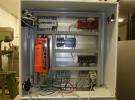Hi,
We are trying to read signal from a Bosch piezoelectric knock sensor using the LabJack T7 Pro. So far, we have not been able to get any signal from the sensor. We tried amplifying the signal using a LJTick-InAmp amplifier and was still not able to get a signal. Does anyone have experience with this type of sensor and the T7?
Here is a link to a webpage where you can find the datasheet:
https://www.ellis-components.co.uk/bosch-motorsport/sensors/p/knock-sensor-ks4-r/in/york
Thanks!



.png%3Fitok=PHGBxf6M)


.jpg%3Fitok=B1YcuDFK)
.png%3Fitok=Ybt-OlgU)
Connect Sig+ to AIN0 and Sig- to GND.
Run LJStreamM. Set #Channels=1 and ScanRate to perhaps 5000. The first row should be have the name AIN0. Set GraphHistory to 10000 (2x the scan rate) so the graph is showing the last 2 seconds of data. Start the stream.
Take the sensor and bang it on your desk or something to see if you get any signal.
If you have not changed the range the default range is +/-10V. Their datasheet does not tell how much signal to expect (ask the manufacturer what to expect if you are banging it on your desk), but I would think you would see it on this range. If you want to use a smaller range you need to close LJStreamM and use Kipling to change the range.
The minimum frequency of the sensor is 3 Hz so bang it on the desk rather quickly.
Their spec says "3 to 25 kHz". It is not clear if that means "3 Hz to 25 kHz" or "3 kHz to 25 kHz".
It does say the sensitivity is 29 mV/g at 5 kHz, so 10 g would give you just 290 mV. No idea what the sensitivity is at 3 Hz, if it even works at 3 Hz.
Hi,
Thanks for the input. I did as you said,
"Connect Sig+ to AIN0 and Sig- to GND.
Run LJStreamM. Set #Channels=1 and ScanRate to perhaps 5000. The first row should be have the name AIN0. Set GraphHistory to 10000 (2x the scan rate) so the graph is showing the last 2 seconds of data. Start the stream."
This seemed to work for 1 sensor, but when I try to read more than one channel (sensor 1 connected to sig + on AIN0, sensor 2 connected to sig + on AIN1 and sig - for both sensors connected to GND) the value of the readings are very different. The difference also varies alot depending what sampling rate is used. If anyone has any input for possible solutions it would be greatly appreciated.
Thank you
Have you tried using the T7's differential analog input channels without using the InAmp?
Testing the T7's differential analog inputs (Using a 1.5 V Battery) without the InAmp. One of the inputs is consistently about .2 volts lower than the other. We are seeing this offset in our sensor readings too. Has anyone seen this before?
Are you using Command-Response or Stream? Either way, the first thing we should try is to increase settling.